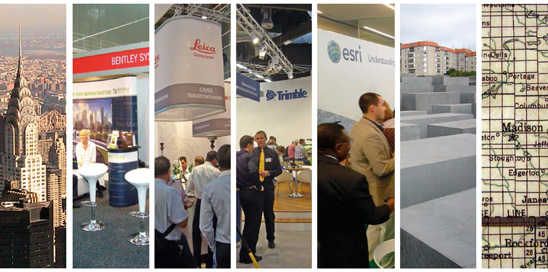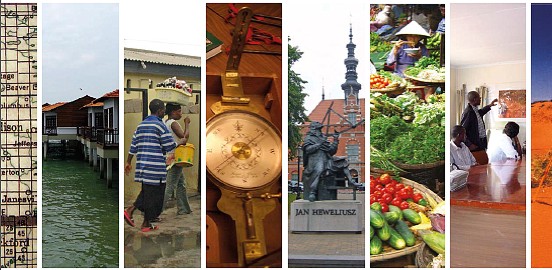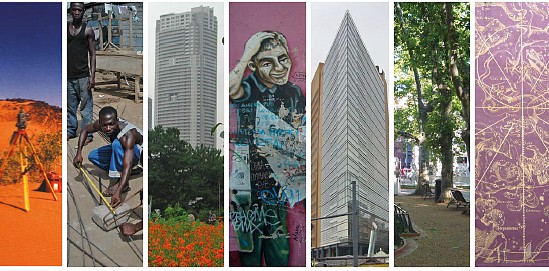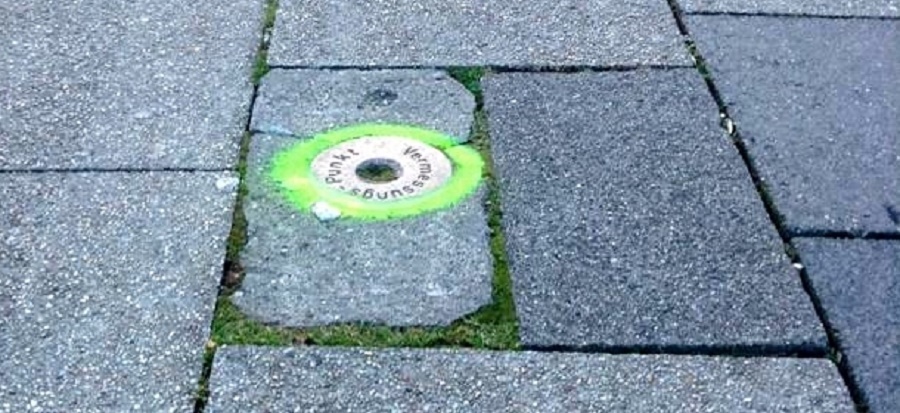
FIG IN BRIEF
FIG is the premier international organization representing the interests
of surveyors worldwide. It is a federation of the national member
associations and covers the whole range of professional fields within the
global surveying, geomatics, geodesy and geo-information community. It provides an international forum for
discussion and development aiming to promote professional practice and
standards.
FIG was founded on July 18 1878 in Paris by delegates from seven national
associations - Belgium, France, Germany, Great Britain, Italy, Spain and
Switzerland - and was known as the Fédération
Internationale des Géomètres. This has become anglicized to the
International Federation of Surveyors. It is a UN-recognized non-government
organization (NGO), representing more than 120 countries throughout the
world, and its aim is to ensure that the disciplines of surveying and all
who practise them meet the needs of the markets and communities that they
serve.
FIG Profile in pdf:
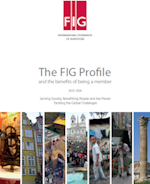
The FIG vision
Surveying is a modern profession acting worldwide for a better
infrastructure for our society and planet earth. The International
Federation of Surveyors (FIG) wants to keep, and even improve, its role as
the premier non-governmental organisation that represents the interests of
surveyors worldwide.
The role of FIG
FIG’s activities are governed by a work plan, which is approved by the
General Assembly and reviewed by Council as its tenure progresses. The
current work plan with the motto “Volunteering for the Future ” guides Council, Commissions, Networks and
Task Force in their activities.
FIG supports the role of a prosperous and sustainable profession of
surveyors to provide solution functionality, reliably, affordably for a
complex and rapidly changing world that cannot wait, and to translate a
sustainable development agenda into action. FIG supports international
collaboration among its members for the progress of surveying in all its
fields and applications. FIG has a close cooperation with United Nations
relevant bodies, World Bank, and its sister associations and has been
globally recognized as the leading international non-governmental
organization on geospatial information and the management of “land”, the
“sea” and the “built” environment. It is within the surveyors’ task to
determine the size and shape of the earth, to map its surface and to manage
it in a sustainable way.
Who are the members of FIG?
FIG draws its membership from practitioners working in communities with
both the public and private sectors, from the scientific, research and
academic community, as well as from the spatial technologies and services
community. FIG functions with the goodwill, resources and contribution of
its memberships and their corp of volunteers from around the world.
Members of FIG consist of:
- member associations – national associations
representing one or more of the disciplines of surveying
- affiliates – groups of surveyors or surveying
organizations undertaking professional activities but not fulfilling the
criteria for member associations
- corporate members – organizations, institutions or
agencies which provide commercial services related to the profession of
surveyor
- academic members – organizations, institutions or
agencies, which promote education or research in one or more of the
disciplines of surveying. An individual may be appointed as a
correspondent in a country where no association or group of surveyors
exist that is eligible to join FIG as a member.
The Benefit of Being a Member
The benefits for all classes of membership of FIG include:
- being part of the global community of surveyors seeking to
extend the usefulness of surveying for the betterment of society,
environment and economy
- international recognition of the national profession and
enhancement of the profile of the international surveying profession
- access to the international surveying community for exchange of
experiences and new developments
- access to surveyors and surveying companies throughout the world
who already have established connections with influential
international bodies
- opportunities through the commission working groups and FIG Task
Forces to take part in the development of many aspects of surveying
practice and the various disciplines, including ethics, standards,
education and a whole range of professional issues
- access to continuing professional development and critical self
evaluation of individual standards and professionalism
- access to institutional FIG support – the global surveying
community – when aiming to improve the educational or professional
standing in society; or improving the national systems for land
registration and land management.
FIG Organisation

Commission activity
Ten commissions lead FIG’s technical work. Each member association
appoints a delegate to each of the commissions. Detailed information on the
work of the commissions, their work plans, working groups, seminars,
newsletters and publications can be found at www.fig.net/organisation/comm/.
The terms of reference are as follows:
The terms of reference are as follows:
Commission 1 - Professional Practice
Chair: Mr. Timothy Burch (United
States)
Perception of surveying profession; professional practice, legal aspects
and organizational structures; standards and certification; code of ethics
and applications; under-represented groups in surveying; students and young
surveyors; information technology management and professional practice;
project management, quality and best practice
Commission 2 - Professional Education
Chair: Dr. Dimo Todorovski
(The Netherlands)
Curriculum development; learning and teaching methods and technologies;
educational management and marketing; continuing professional development;
networking in education and training.
Commission 3 - Spatial Information Management
Chair: Dr. Sagi Dalyot (Israel)
Management of spatial information about land, property and marine data;
spatial data infrastructure – data collection, analysis, visualisation,
standardisation, dissemination, and support of good governance; knowledge
management for SIM; business models, public-private-partnerships,
professional practice and administration.
Commission 4 - Hydrography
Chair: Dr. Malavige Don Eranda Kanchana Gunathilaka (Sri
Lanka)
Hydrographic surveying; hydrographic education, training and CPD; marine
environment and coastal zone management; data processing and management;
nautical charting and bathymetric maps – analogue and digital, including
electronic navigational charts.
Commission 5 - Positioning and Measurement
Chair: Dr. Ryan Keenan (Australia)
The science of measurement including instrumentation, methodology and
guidelines; the acquisition of accurate and reliable survey data related to
the position, size and shape of natural and artificial features of the earth
and its environment and including variation with time.
Commission 6 - Engineering Surveys
Chair: Prof. Dr. Werner Lienhart (Austria)
Acquisition, processing and management of topometric data; quality
control and validation for civil engineering constructions and manufacturing
of large objects; modern concepts for setting-out and machine guidance;
deformation monitoring systems; automatic measuring systems, multi-sensor
measuring systems; terrestrial laser systems.
Commission 7 - Cadastre and Land Management
Chair: Dr. Rohan
Bennett (Australia)
Cadastre, land administration and land management;
development of pro poor land management and land administration; development
of sustainable land administration as an infrastructure for sustainable
development to underpin economic growth; applications of innovative and
advanced technology in cadastre and land administration; promoting the role
of surveyors in land administration matters to the public and stakeholders.
Commission 8 - Spatial Planning and Development
Chair: Mr. Kwabena Asiama (Ghana)
Regional and local structure planning; urban and rural land use planning
and implementation; planning policies and environmental management for
sustainable development; re-engineering of mega cities; public-private
partnerships; informal settlement issues in spatial development, planning
and governance.
Commission 9 - Valuation and the Management of Real Estate
Chair: Mr. Peter R. Ache (Germany)
Valuation; investment in real estate and investment planning; real estate
investment vehicles; real estate, development finance and land use
feasibility planning; real estate economics and markets and market analyses;
management of property and property systems; management of public sector
property.
Commission 10 - Construction Economics and Management
Chair: Ms. Mercy Iyorter (Nigeria)
Construction economics, including quantity surveying, building surveying,
cost engineering and management; estimating and tendering; commercial
management including procurement, risk management and contracts; project and
programme management including planning and scheduling.
Networks
Young Surveyors Network
Chair: Ms. Shirley Chapunza
(Zimbabwe)
FIG Young Surveyors Network addresses the need for young surveyor
representation within FIG, and the need to ensure FIG activities are meeting
the needs of students and young professionals.
Regional Capacity Development Network
Chair: Dr. Diane Dumashie (RICS,
United Kingdom)
Africa: Chair: Mr.
Mohammed Mamman Kabir
(Nigeria)
America: Chair: Mr. Dan Roman
(United States)
Asia/Pacific: Chair: Mr. Robert Sarib
(Australia)
This network originates from the Africa Task Force 2009–2014 and was
transformed into a Network.
Standards Network
Chair: Mr. David Martin (ESRF,
France)
Standards are continuously important in the work of surveyors. In 2012
the Standards Network succeeded in publishing the Land Administration Domain
Model (LADM) as ISO Standard19152.
Permanent Institutions
International Institution for the History of Surveying & Measurement
(IIHSM)
Director: Mr. Jan de Graeve (UBGE,
Belgium)
The International Office for Cadastre and Land Records (OICRF)
Director: Dr. Eva-Maria Unger (Austria)
Task Forces 2023–2026
FIG Task Force on FIG and the Sustainable Development Goals
Chair: Ms. Paula
Dijkstra (the Netherlands)
The task force identifies relevant SDGs for FIG and its Commissions,
assesses the needs, requirements and opportunities for FIG and explores
solutions, approaches, curricula and tools to boost the achievement of the
SDGs
FIG Task Force on Climate Compass
Co-Chairs: Ms. Roshni Sharma (Australia) and Ms.
Clarissa Augustinus (Ireland)
The task force will examine and actively promote the engagement and
role that surveyors can have in contributing to the climate change
agenda.
FIG Task Force on Geospatial Information Ecosystem
Co-Chairs: Mr. Prof Abbas Rajabifard (Australia)
and Ms. Dr. Kirsikka Riekkinen (Finland)
The Task Force centred upon the involvement of our profession in
geospatial fields to re-position its international standing and assert
the essential relevance of geospatial experts in international markets.
FIG Task Force on Evolutionary Diversity and Inclusion
Chair: Mr. Stephen Djaba (Ghana)
The task force aims to promote diversity and inclusion within the
surveying profession, not only in terms of race, gender, and ethnicity,
but also in terms of age and generational diversity, including Gen X, Y,
and Z.
The FIG Foundation
President: Mr. Bryn Fosburgh (USA)
The FIG Foundation is an independent body under the Federation giving grants
and scholarships to support education and capacity building especially in
developing countries. Contributions are received
through conferences, corporations, and private donators.
How does FIG operate?
The commissions prepare and conduct the programme for FIG’s international
congresses, held every four years, and annual working weeks, held in the
intervening years. The two previous congresses were held in Kuala Lumpur
(Malaysia) in 2014 and Istanbul (Turkey) in 2018. The next congress will be
held in 2022 in Warsaw (Poland). Congresses attract
several thousand participants from all over the world and are the most
important events in the FIG calendar. The technical programme, which marks
the culmination of each commission’s four-year programme of work, is
complemented by a major international exhibition.
Working Weeks combine meetings of FIG’s administrative bodies with
technical conferences organized by the commissions and the host member
association and as such provide the opportunity for commissions to implement
and develop their work programmes and for FIG to network at a more regional
level. In 2019 the Working Week was held in Hanoi (Vietnam). Due to Covid-19
the Working Week 2020 was replaced with an article series and in 2021 it was
organized, together with Dutch local organizers, as an online event. The
2023 Working Week takes place in Orlando, United States. To increase regional activities FIG also organizes regional
conferences, the most recent of which was held in Uruguay in November 2012.
In addition to their involvement with FIG congresses and working weeks,
commissions and their working groups organize or co-sponsor a wide range of
seminars and workshops, usually in collaboration with member associations or
other international professional bodies.
A key element to the success of a commissions work is the appointment of
national delegates, providing a unique opportunity for professional
development. Member associations, affiliates, corporate members and academic
members are all entitled to appoint delegates to the commissions; and
commission chairs often co-opt additional experts to assist with particular
aspects of their work programmes.
How is FIG administered?
By its General Assembly which meets annually during the FIG Working Week
or the FIG Congress. The General Assembly comprises of delegates of the
member associations and, as non-voting members, the Council, commission
chairs and representatives of affiliates, and corporate and academic
members. The General Assembly debates and approves policies and implemented
by the Council.
The Council is elected by the General Assembly. The Council consists of
the President (elected for four year term of office) and four Vice
Presidents (term of office is four years) with two of the Vice Presidents
being elected every second year, and coming from different countries
throughout the world. In addition commission chairs appoint their
representative to the Council.
The work of the General Assembly and the Council is assisted by an
Advisory Committee of Commission Officers (ACCO); ad hoc task forces
appointed from time to time to review existing work plans; three networks;
and two permanent institutions.
FIG Council members 2023–2026
President:
- Dr. Diane Dumashie (United
Kingdom) (2023–2026)
Vice-Presidents:
- Ms. Winnie Shiu (Hong
Kong, China) (2023–2026)
- Dr. Daniel Steudler (Switzerland) (2023–2026)
- Prof. Qin YAN (China) (2025-2028)
- Mr. Michalis Kalogiannakis (Greece) (2025-2028)
- ACCO Representative: Mr. Ryan Keenan (Australia)
(2025–2026)
- Young Surveyors Network representative: Mr. Iaroslav Zifceac
(Romania) (2025-2026)
- Corporate members representative: Mr. Brent Jones, ESRI
Term 2023-24:
- Mr. Mikael Lilje (Sweden) (2021–2024)
- Mr. Kwame Tenadu (Ghana) (2021-2024)
- ACCO Representative: Mr. Timothy
Burch (United States)
(2023–2024)
- Young Surveyors Network representative: Ms. Shirley Tendai
Chapunza (Zimbabwe) (2023-2024)
- Corporate members representative: Mr. Brent Jones, ESRI
For details on the current council see:
www.fig.net/organisation/council/
FIG Office
The FIG Office is located in Copenhagen, Denmark.
Address:
FIG Office
Kalvebod Brygge 31-33,
DK-1780 Copenhagen V, Denmark.
Tel: +45 3886 1081
E-mail: fig@fig.net
Further information about the FIG office at:
www.fig.net/about/office/index.asp
How Does FIG Communicate?
- Through the FIG home page www.fig.net,
which is the main medium of external communication.
- The FIG annual
review – an overview of major activities and achievements (available on
www.fig.net/about/annual_review/).
- The FIG e-Newsletter – a monthly
newsletter and the main medium of internal communication (available
through subscription on
www.fig.net/resources/subscriptions/getnewsletter.asp).
- The FIG
publications series – formal policy statements, guidelines, and reports
(available on
www.fig.net/resources/publications/figpub/).
- Proceedings of FIG congresses and of selected technical seminars
sponsored or co-sponsored by FIG’s commissions and member associations
(available on www.fig.net/resources/proceedings/).
- Commission news –
for the dissemination of information specifically concerned with the
work of individual commissions (available on
www.fig.net/organisation/comm/ ).
- Social media.
How Is FIG Financed?
Members’ annual membership fees largely finance operating costs.
Rates of membership fees payable by member associations are approved
annually by the General Assembly. The Council sets rates of membership
fees payable by affiliates, corporate and academic members.
Other activities, including congresses, technical seminars and
administrative meetings, are mostly self-financing. In the case of
meetings, income is raised from registration fees, which may be
supplemented by income from an accompanying technical exhibition, by
subventions from the host government or association, or by grants from
aid agencies.
FIG International Co-Operations
FIG international co-operations include:
- UN agencies, notably the United Nations Human
Settlements Programme (UN-HABITAT), the Food and Agricultural
Organization (FAO), the United Nations Global Geospatial Information
Management (UN-GGIM), United Nations Environment Programme (UNEP),
the United Nations Office for Outer Space Affairs (UN OOSA) and the
World Bank, as well as United Nations Economic Commission for Europe
(UN-ECE), United Nations Economic Commission for Africa (UNECA), the
UN sponsored United Nations Regional Committee for Global Geospatial
Information Management for Asia and the Pacific (UN-GGIM-AP) and
Permanent Committee on SDI for the Americas (PC IDEA), and United
Nations Regional Cartographic Conferences (UNRCC). Joint workshops
and other collaborative projects help to identify and develop
practical solutions to problems associated with the ownership and
management of land. FIG is officially recognised by the United
Nations Economic and Social Council (ECOSOC).
- International professional organizations in surveying
disciplines through the Joint Board of Spatial Information
Societies that includes organizations such as the International
Association of Geodesy (IAG), the International Cartographic
Association (ICA), the International Hydrographic Organization
(IHO), the International Society for Photogrammetry and Remote
Sensing (ISPRS), and the Global Spatial Data Infrastructure
Association (GSDI). Furthermore, FIG has formal co-operation with
the International Society for Mine Surveying (ISM), Pan-American
Institute of Geography and History (PAIGH) and the International
Federation of Hydrographic Societies (IFHS). FIG is also an
international scientific associate of the International Council for
Science (ICSU).
The Benefit of Being a Member
The benefits for all classes of membership of FIG include:
- being part of the global community of surveyors seeking to
extend the usefulness of surveying for the betterment of society,
environment and economy
- international recognition of the national profession and
enhancement of the profile of the international surveying profession
- access to the international surveying community for exchange of
experiences and new developments
- access to surveyors and surveying companies throughout the world
who already have established connections with influential
international bodies
- opportunities through the commission working groups and FIG Task
Forces to take part in the development of many aspects of surveying
practice and the various disciplines, including ethics, standards,
education and a whole range of professional issues
- access to continuing professional development and critical self
evaluation of individual standards and professionalism
- access to institutional FIG support – the global surveying
community – when aiming to improve the educational or professional
standing in society; or improving the national systems for land
registration and land management.
For further information about FIG and its activities consult the
homepage at: www.fig.net

























